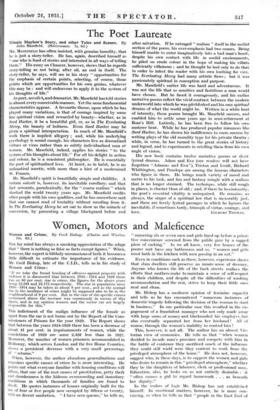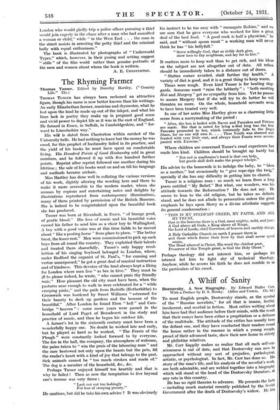Women, Motors and Maleficence
Women and Crime. By Cecil Bishop. (Chatto and Windus.
. 10s. 6d.) -- .
TIIE lay mind has always a sneaking appreciation of the adage that " there is nothing so false as facts except figures." When, however, the expert is blithely unconscious of both it becomes a little difficult to estimate the importance of his evidence. Mr. Cecil Bishop, late of the C.I.D., tells us in his study of Women and Crime : " If we take the broad heading of offences against property with violence it is discovered that between 1910-1914 and 1928 there was an 80 per cent. rise in crime, the figures fOr the above years being 12,284 and 22,172 respectively. The rise in population since 1910-4914 may be taken as about 9 per cent., and so the normal rise in the incidence of crime might be supposed also to be in the neighbourhood of 9 per cent. But in the ease of the specific crimes mentioned above the increase- was enormously in excess of this figure, and in my opinion women and the motor car are largely responsible for this."
This indictment of the malign influence of the female as apart from the car is not borne out by the Report of the Com- missioners of Prisons for the year 1929. The Report shows that between the years 1924-1929 there has been a decrease of
about 41 per cent. in imprisonments of women, while the convictions of 1929 are some 2,428 less than in 1927. Moreover, the number of women prisoners accommodated in Holloway, which serves London and the five Home Counties, shows a persistent decrease with a very small percentage of returns."
When, however, the author abandons generalizations and examines specific causes of crime he is more interesting. He points out what everyone familiar with housing conditions will affirm, that one of the root causes of prostitution, petty theft and drimkenne_ss is the hideous overcrowding and insanitary conditions in which thousands of families are found to dwell. He quotes instances of houses originally built for the use of four or five people now occupied by fifteen or twenty, with no decent sanitation. " I have seen queues," he tells us, " numering six or seven men and girls lined up before a primi- tive convenience screened from the public gaze by a ragged . piece of sacking." As we all know, very few houses of the poorer sort have any bathrooms and so, " women and girls must bath in the kitchen with men passing in an out."
Even in conditions such as these, however, experience shows that slum dwellers still preserve an innate sense of decency, Anyone who knows the life of the back streets realizes the efforts that mothers make to maintain a sense of self-respect in their children, and despite all the difficulties of washing accommodation and the rest, strive to keep their little ones neat and clean.
Mr. Bishop has a mediocre opinion of feminine capacity and tells us he has encountered " numerous instances of domestic tragedy following the decision of the woman to start in business." In one particular case this resulted in the en- gagement of a fraudulent manager who not only made away with large sums of money and blackmailed his employer, but also eventually separated her from her husband ! All of course, through the woman's inability to control him !
This, however, is not all. The author has an almost Vic- torian view of economics. He tells us that " when women decided to invade man's province and compete with him in the battle of existence they sacrificed much of the influence they could still wield were they content to work from the privileged atmosphere of the home." He does not, however, suggest who, in these days, is to support the women and girls who desire to remain in this " privileged atmosphere," whether they be the daughters of labourer, clerk or professional man. Education, also, he looks on as not entirely desirable : it " often causes a girl to regard housework . . . as beneath her dignity."
In the realms of logic Mr. Bishop has not established himself. In emotional matters, however, he is more con- vincing, as when he tells us that " people in the East End of London who would gladly trip a police officer pursuing a thief would join eagerly in the chase after a man who had assaulted a woman or child," while " in the West End . . . the man in the street assists in arresting the petty thief and the criminal bully with equal enthusiasm."
The book is illustrated by photographs of " Underworld Types," which, however, in their posing and setting suggest " stills " of the film world rather than genuine portraits of the men and women about whom the book is written.
A. E. CHESTERTON.















































 Previous page
Previous page